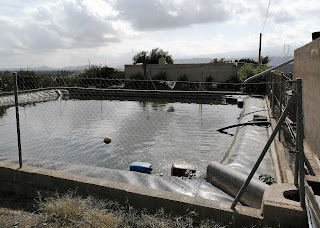In the
eighties, a bumper-sticker plastered on the back of a number of vehicles
in the USA’s most intriguing state would read ‘Welcome to California.
Now Go Home’. Behind the wheel of the old rust-bucket bought from a
dealer in Detroit (where else?), I felt a bit of an interloper driving
around The Golden State with my travellers cheques, my snappy British
accent and my half-empty jar of Ovaltine.
Tourism may not have been such a Big Thing in California, despite the popular song from Supertramp (here ya go) and the steady arrival of farmers from the Dust Belt looking for a decent job; but, at 12% of GDP (here),
it’s certainly a Big Thing in Spain. Before the pandemic, around twice
as many foreign tourists chose to enjoy Spain's charms as there are
Spaniards living here. And, if that was not enough – with two people
dressed in lederhosen, or with peeling noses, or perhaps
wearing sticky ‘Gibraltar is British’ tee-shirts for every Spaniard, you
can add the huge numbers of displaced Spaniards themselves – everyone
has a right to a vacación – flocking to the same destinations.
Those resorts will have put up the flags, organised a fiesta and
will be ready for the onslaught. Shops full of glitter, bars with cold
beer and restaurants with fresh fish. The late night joints will be
buzzing and the cops will be on every corner, complacently fingering
their books of fines. A loud midnight buzz of people, fun, parties, botellones,
noise, fire-crackers, sirens, arguments, screams, music, songs and the
burble and bang from those irritating Harley Davidsons... The following
morning, there’s the rubbish to clean up.
Money is made, vast amounts of money for the shop-keepers, the
apartment owners, the barkeeps, the souvenir shops: the municipality
itself – but that’s no consolation for the normal folk, those who live
here year round, working in ordinary jobs or retired, who must somehow
get through their day: past the jams, the queues, the noise and the
dust.
The town fiesta: costumes and spectacle, paid with our taxes, is so
full of visitors, that there’s no parking, no room, and no welcome for
the locals who with resignation will decide to stay home and see it on
the telly. ‘We’ll go next year’ they say.
The apartment block: with half of the flats rented out, a two-bed
apartment with twelve people staying there, filling the pool for a
late-night dip, uprooting the flower bed and being sick in the lift.
So now we have a new word: la turismofobia. And we read
the headlines, particularly about Barcelona and Madrid, Granada and
Palma, where the cities are taken over by the tourist hoards. How can
one rent an apartment when the owner can earn five or ten times as much
as a weekly tourist-let (legal or otherwise)? The football hooligans,
over for a match between one of their and one of ours. The drunken
swarms of young foreigners bellowing and vomiting their way across the
coast-road. The staggering numbers of flights into Spain (275 million
people passed through a Spanish airport in 2019). Then there are the
cruise ships, with their sudden massive influx into the local port.
Worst of all, we simple guiris, as we negociate our way
through the crowds of trippers, must make that same answer, over and
over again: 'No, I'm no tourist, I live here'. In the old days, we stuck
out by not carrying a camera. Now we have to wear long trousers
instead.
This is a fabulous country and there are few better places to live;
but on the car, there’s a new sticker. It reads: ‘Welcome to Spain. Now
Go Home’.

